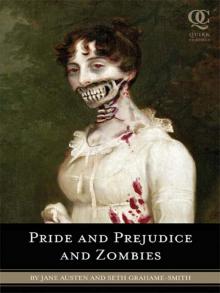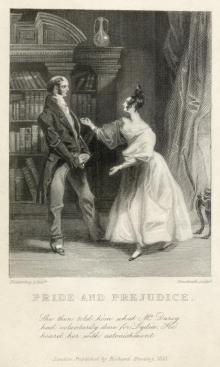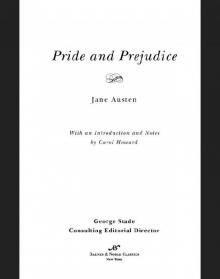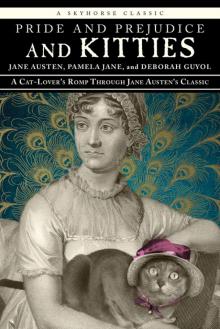- Home
- Jane Austen
Northanger Abbey (Barnes & Noble Classics) Page 2
Northanger Abbey (Barnes & Noble Classics) Read online
Page 2
The kinds of prose fiction produced during the late eighteenth century, all of which shape Northanger Abbey, fall into two general types, and despite their diversity they overlap considerably. First there is the gothic novel, read with delight by Catherine Morland and her false friend Isabella Thorpe, in chapter VI (pages 33-35), as well as Catherine's husband-to-be Henry Tilney, in chapter XIV (pages 99 and following). The gothic novel marks the transition in European culture from the Age of Reason to the Romantic Era. It seeks to arouse the irrational in the reader--fear, horror, amazement, dread--and uses any means possible to achieve that goal. If the Enlightenment sought to dismiss superstition, magic, and the irrational, the gothic novel brings all those back with a vengeance.
Beginning in 1764 with Horace Walpole's The Castle of Otranto and continuing well into the nineteenth century with Mary Shelley's Frankenstein; Or, the Modern Prometheus (1818), the gothic novel probes the dark side of the human mind. Its settings are often (not always) haunted castles located in remote forests, but what these locations reflect is the discovery of the hidden recesses of the human mind. What is a ghost, after all, but a repressed memory, the past demanding to be heard in the present? What are the dungeons and secret passages in fantastic castles if not the places in the human mind where the subconscious hides and our darkest secrets wait to be discovered?
These fictions, strong on action and setting but weak in character development and plausibility, are remarkably durable: They are the stuff of our science fantasy or horror films, our recurring need to be frightened by vampires, werewolves, or monstrosities constructed from body parts. They are popular lit erature in the sense that their appeal is broad and not directed to a highly literary and, presumably, refined reading public. At the same time, as Austen's character Henry Tilney (a clergy man) shows, even the well-educated, sophisticated reader can enjoy the thrills of the gothic novel.
Gothic "novels" are actually romances, a kind of prose fiction that differs in important ways from the true novel. They deal with passions and the characters who embody them and use settings appropriate for actions unsuited to ordinary civil society. They arouse emotions but do not seek to entrance the reader with the depiction of a mind in the process of development. That is the task of the true novel, which seeks to give us the inner lives of ordinary people who evolve over time, like the societies in which they live. Northanger Abbey traces the life of an eighteen-year-old woman, Catherine Morland, as she moves from an awkward adolescence into maturity and marriage. But it also traces the life of a reader, the same Catherine Morland, who finds herself spellbound by gothic romance and imagines real life to be a mirror of that kind of fiction and herself a heroine of romance, until Henry Tilney shows her how foolish she is: From then on, she behaves like a character in a true novel.
Austen's model for the study of the effects of reading romances is Miguel de Cervantes (1547-1616), whose Don Quixote goes mad from reading romances about knights in armor rescuing damsels in distress and slaying dragons. Cervantes sets a pattern used by countless authors: He writes about the disastrous effects of reading. Don Quixote becomes not a knight in armor but a knight from romance as he makes his way across an all-too-real seventeenth-century Castile. The disparity between his perception of the world (windmills become giants; flocks of sheep become armies) and reality produces comedy. Readers of Austen's other novels, especially Emma (1816), will recall how often she uses this idea of the deluded heroine.
Cervantes provides another prototype for the novel: a fiction in which characters read books, discuss them, and react to them. Northanger Abbey goes to great length to differentiate it self from romance, and Catherine Morland, a quixotic young woman who sees things through the distorting lens of the gothic novel, must grow out of that illusion. In doing so, she follows the trajectory typical of all true novels: She moves from innocence to experience. Catherine must change; she must react to life and become, by the end of her story, another person. This is exactly what romance characters cannot do. They are what they are from start to finish.
And the world of romance is as static as its characters, while the world of the novel is as susceptible to change as are its characters. Thus the novel marks a major transformation not only of literary characters--they will evolve and have inner lives--but of the world represented in literature. Society in the novel is not fixed but filled with transformations. This reflects the dynamic concept of history that becomes dominant during Austen's lifetime, the view of history (and, ultimately, nature, as Charles Darwin will later demonstrate) we find in the writings of Georg Wilhelm Friedrich Hegel (1770-1831), who defines the process of history as a series of conflicts between opposing energies.
Northanger Abbey is a threshold text, a transition point in the history of the novel, and Austen's narrative technique reveals this. Her narrator, whose voice we often assume to be Austen's, is omniscient, but frequently she assumes a familiar tone in order to create a sense of intimacy with readers, who find themselves addressed directly. The narrator assumes different roles: biographer, chronicler, literary critic, and story-teller. All these shifts show how Austen borrows from her immediate literary tradition in order to fashion a new synthesis.
In her opening sentence, Austen flaunts the insignificance of Catherine Morland in order to draw a parallel between her close focus on ordinary, provincial people, and the heroic world of epic or chivalric romance:
No one who had ever seen Catherine Morland in her infancy, would have supposed her born to be an heroine. Her situation in life, the character of her father and mother, her own person and disposition, were all equally against her (p. 7).
If we substitute the name Joan of Arc for that of Catherine Morland, we see just how much irony Austen infuses into those first sentences. That is, we are prepared for something other than what we get: Just when we imagine that despite her insignificant origins Catherine Morland will rise to be the savior of her nation, we get the exact opposite. There is no chance that Catherine will ever be a heroine in the epic or tragic sense.
Thus we slip without noticing it into comedy of a satirical vein. Here is Catherine in a bizarre family portrait:
Her father was a clergyman, without being neglected, or poor, and a very respectable man.... Her mother was a woman of useful plain sense, with a good temper, and, what is more remarkable, with a good constitution. She had three sons before Catherine was born; and... lived to have six children more.... A family of ten children will be always called a fine family, where there are heads and arms and legs enough for the number; but the Morlands had little other right to the word, for they were in general very plain, and Catherine, for many years of her life, as plain as any (p. 7).
Austen's rhetoric is deflationary and ironic. Catherine's father is well-off without being rich, but he is homely; her mother is even-tempered and healthy enough to have ten children--a remarkable feat in a time when childbirth often proved mortal to mothers and babies. But the ten children look like ten potatoes, all sound in mind and body but just a notch above ugly.
But what do these characters look like? Austen makes no attempt to paint verbal portraits of them, and that applies even to her heroine: "She had a thin awkward figure, a sallow skin without colour, dark lank hair, and strong features;--so much for her person" (p. 7). This is a species of Gestalt portrait, in which we are given the barest details and required to add the rest out of our own imagination; even then, we would have to invent the psychological details.
Later, when Austen informs the reader about Catherine Morland's femininity and intelligence, she simply presents her as a tomboy "fond of all boys' plays" and "often inattentive, and occasionally stupid" (pp. 7-8). This technique of deliberate abstraction invites reader participation, and that involvement is essential to Austen's enterprise. Unlike French novelists of the nineteenth century--Honore de Balzac or Gustave Flaubert, for example--Austen does not seek to recreate a world by filling the page with descriptions of people and objects. She is a realist,
but only to a point; that is, she is more concerned with involving the reader in the production of something that cannot be seen--the moral development of a heroine who sees reality for what it is. In that structure, objects would only be frivolous clutter, and we see that characters who do fret a great deal about clothes or possessions (Isabella and John Thorpe) are morally inferior to Catherine.
We must distinguish the school of Realism typical of the French novel from Austen's technique of suggested reality. We should, she seems to say, focus our attention not on objects and setting but on a process, a development. Sure enough, no sooner do we recover from Austen's introductory hymn to the banality and mediocrity of her protagonist than we see that there is hope for Catherine after all:
At fifteen appearances were mending; she began to curl her hair and long for balls; her complexion improved, her features were softened by plumpness and colour, her eyes gained more animation, and her figure more consequence (pp. 8-9).
Catherine is improving physically, but she is still an abstraction. Austen accelerates her aging, moving her from ten to fifteen to seventeen in three pages and limiting her intellectual development to a smattering of poetry and Shakespeare's plays. Now she turns her maturation into physical motion by arranging for Catherine to accompany to Bath the gout-plagued Mr. Allen, "who owned the chief of the property about Fullerton, the village in Wiltshire where the Morlands lived" (p. 11), and his fashion-obsessed wife. Mrs. Allen's addiction to clothing is a symptom of her superficiality, and Austen never allows her to rise above the tedious prattle of a fool in her conversation.
In Western literature, spatial displacement--be it exile, homecoming, adventure-seeking, or simple travel--is usually connected to a character's moral, intellectual, or psychological growth. Space in Dante's Divine Comedy (c.1310-1314), for example, is moral: Dante moves through the realm of the damned in Inferno to the space of hope in Purgatory, and ends in the bliss of salvation when he reaches Paradise. The reader accompanies Dante not only physically but morally as well. As we travel to Bath with Catherine Morland, we see that her departure from Fullerton is a leaving behind of childhood innocence, that Bath is, like Vanity Fair in John Bunyan's Pilgrim's Progress (1678), a text Austen would have absorbed early in life, a place of temptation and deception.
These seductive forces appear when the lonely Catherine, adrift in Bath and accompanied only by Mrs. Allen, who as moral guide is worthless, meets Isabella Thorpe. Isabella is the eldest of the three daughters of Mrs. Thorpe, "a widow, and not a very rich one," and the brother of John, a student at Oxford and a friend of Catherine's brother James. Isabella is four years older than Catherine, and by late-eighteenth-century standards at a time in life when marriage is a dire necessity. Her brother, the thuggish John Thorpe, a hard-drinking, swearing braggart, will inherit what there is of his mother's estate, so she must find a husband. Through her brother, she finds James Morland and becomes engaged to him.
Austen embodies the idea of deception in the Thorpes, whose literary pedigree links them to similar characters in comedy and satire, but carefully includes self-deception along with it. She suggests that those who seek to blind others to their machinations are themselves blind to the treachery they create for themselves. Isabella desperately wants to marry James until, of course, a better prospect appears: Frederick Tilney, Henry's older brother, a dashing army captain. By the same token, John Thorpe would like to marry Catherine, mistakenly assuming that because the Allens have no children they will leave their fortune to Catherine.
How they work their deception is another aspect of Austen's moral concept of space. Like a religious cult or a radical political party recruiting new members, they use every means at their disposal to isolate Catherine from the rest of Bath, especially from Henry Tilney, an eligible bachelor Catherine has already met. If the Thorpes can bring James and Catherine under their control, they will, or so they think, have made very advantageous matches.
Catherine's only defense against Isabella and John Thorpe is her own innocence: Austen herself, in a letter of 1817, quipped: "You may perhaps like the Heroine, as she is almost too good for me." Having no guile of her own, Catherine is not susceptible to the guile of others. She does succumb to Isabella's offer of female friendship, and the two share a common interest, the gothic romances of Ann Radcliffe; so when Isabella's falsity finally reveals itself in a letter (p. 203)--Catherine is reading again, only this time with clear vision--she is deeply wounded. But in order to discover the duplicity of Isabella and John, Catherine must leave Bath. In doing so, she gains perspective on her acquaintances and herself--perspective, again, both in a pictorial and a moral sense: She sees things as they are, not as words deform them. That it is Henry Tilney (p. 104) who instructs Catherine on the concept of perspective is yet another affirmation of his didactic role in her life: He will be older brother and husband to her.
To get Catherine out of Bath without returning her to Fullerton, Austen transports her to a false paradise, Northanger Abbey, the estate of General Tilney, father to Henry, Frederick, and Eleanor. At Bath, Catherine dances with Henry, is immediately attracted to him, and becomes the friend of Eleanor, the antithesis of Isabella. The geometric symmetry of the five individuals is striking: Catherine Morland stands between two couples, brothers and sisters, the Thorpes and the Tilneys. Outside that configuration rove two other men, James Morland and Frederick Tilney.
About James we know only that he is an eldest son, thus an heir, and Catherine's beloved brother. About Frederick we know only that he is General Tilney's heir and, like his father, a military man at a time when commissions were purchased rather than earned through service. They are symmetrical but unequal, since Frederick is heir to a vast fortune while James will inherit only a modest estate. Austen's final symmetry is only partial: Mrs. Thorpe, the impecunious widow, is set off against General Tilney, the wealthy widower. They both, obeying the social imperatives of the day, seek the best possible matches (financially speaking) for their offspring, but go about the business in different ways: Mrs. Thorpe leaves the scheming to her children, while the General attempts to take command of the enterprise-he is, after all, a general.
He is as obsessed with modernizing his estates as Mrs. Allen is about keeping up with fashion. He has redecorated Northanger Abbey in the latest style, much to the chagrin of Catherine, who is fascinated with medieval artifacts when she arrives at the Abbey, and the kitchen contains "every modern invention to facilitate the labour of the cooks" (pp. 172-173). General Tilney runs his estate as if it were a military garrison: Everything must run like clockwork, even the hothouses, which produce pineapples in the middle of England. We are hardly surprised that such a martinet would try to link his children to scions of the highest social ranks.
Austen's linear progression now twists and turns as Catherine is pulled one way by the Thorpes and another by the Tilneys. The reader may imagine Northanger Abbey to be Catherine's refuge from the Thorpes, and it is that, but it is not a refuge from two other negative forces: the General and Catherine's own self-deceptions. The General, misinformed by the misinformed John Thorpe about Catherine's financial expectations, becomes enraged when Thorpe, thwarted in his plans to marry Catherine, tells him she's penniless. He summarily exiles her from Northanger Abbey. Catherine, on the other hand, comes to Northanger assuming it is the setting of a gothic romance and turns the General into one of Ann Radcliffe's villains. Henry Tilney, acting both as sage older brother and pedagogic future husband, disabuses her of such silly ideas. In literary terms, the moment General Tilney ceases to be the ogre of gothic romance, he becomes the blocking figure of Shakespearean comedy, the elder who keeps hero and heroine from marrying.
Thus it is a doubly wiser Catherine who makes the sad journey back to Fullerton: She now knows life and literature are two different things, and knows as well that no human being, even one as godlike as General Tilney, is exempt from vanity and self-deception. She travels in a circle, but that circle is hardly a zero
. She exchanges innocence for experience without sacrificing her own innate honesty. She needs only to be rescued, not by a knight in shining armor, but by a clergyman driving a carriage, Henry Tilney.
Austen writes at the outset of a total metamorphosis of European thought, a moment when every aspect of society was on the verge of mutation. The most obvious change is political: France enters the process of the French Revolution in 1789 and moves into the era of Napoleon, from which it emerges only after Napoleon's defeat at Waterloo in 1815. France, in only a few years, moves from monarchy to republic to empire and back to monarchy. The spirit of the eighteenth-century Age of Reason, with its emphasis on universal principles (such as "All men are created equal") turns into the age of Romanticism, when individuals discover they are radically different from one another.
Austen's sociology too reflects an evolving literary, political, and social reality. Her main characters are not nobles, though some may be members of the titled aristocracy. Catherine Morland is the daughter of a country clergyman; she's seen nothing of the world until her visit to Bath, a health spa and meeting place for marriageable young men and women, and her subsequent brush with provincial highlife at the grand estate of General Tilney, the father of the clergyman she eventually marries. The novel, as Austen and her contemporaries conceive it, is not concerned with kings and queens but with ordinary people, and one wonders if she had any knowledge of Madame de Lafayette's The Princess of Cleves (1678), an early transformation of the aristocratic and courtly setting of the romance of chivalry into something very much like the psychological novel. The novel's task is to make ordinary, usually middle-class characters interesting by creating predicaments for them in circumstances its readers would find reasonably familiar. Austen has a strong cohort of women novelists among her contemporaries who did exactly that; she refers specifically (p. 32) to Cecilia; Or, Memoirs of an Heiress (1782) and Camilla; Or, a Picture of Youth (1796), by Fanny Burney, as well as Belinda (1801), by Maria Edgeworth: The fact that these novels are all named after their heroines certainly influenced Austen, who in its earlier incarnations gave Northanger Abbey the title "Susan" and then "Catherine."

 Sense and Sensibility
Sense and Sensibility Persuasion
Persuasion Mansfield Park
Mansfield Park Northanger Abbey
Northanger Abbey Pride and Prejudice and Zombies
Pride and Prejudice and Zombies Pride and Prejudice
Pride and Prejudice Emma
Emma Persuasion (Dover Thrift Editions)
Persuasion (Dover Thrift Editions) Lady Susan
Lady Susan Northanger Abbey (Barnes & Noble Classics)
Northanger Abbey (Barnes & Noble Classics) Lady Susan, the Watsons, Sanditon
Lady Susan, the Watsons, Sanditon Darcy Swipes Left
Darcy Swipes Left Persuasion: Jane Austen (The Complete Works)
Persuasion: Jane Austen (The Complete Works) Mansfield Park (Barnes & Noble Classics Series)
Mansfield Park (Barnes & Noble Classics Series) Sense and Sensibility (Barnes & Noble Classics Series)
Sense and Sensibility (Barnes & Noble Classics Series) The Annotated Sense and Sensibility
The Annotated Sense and Sensibility Pride and Prejudice (Clandestine Classics)
Pride and Prejudice (Clandestine Classics) Persuasion (AmazonClassics Edition)
Persuasion (AmazonClassics Edition) Persuasion (Barnes & Noble Classics Series)
Persuasion (Barnes & Noble Classics Series) Complete Works of Jane Austen
Complete Works of Jane Austen The Watsons and Emma Watson
The Watsons and Emma Watson Northanger Abbey and Angels and Dragons
Northanger Abbey and Angels and Dragons Love and Friendship and Other Early Works
Love and Friendship and Other Early Works Emma (Barnes & Noble Classics Series)
Emma (Barnes & Noble Classics Series) Sanditon
Sanditon Pride and Prejudice (Barnes & Noble Classics Series)
Pride and Prejudice (Barnes & Noble Classics Series) Pride and Prejudice and Kitties
Pride and Prejudice and Kitties The Annotated Northanger Abbey
The Annotated Northanger Abbey Oxford World’s Classics
Oxford World’s Classics Northanger Abbey (Barnes & Noble Classics Series)
Northanger Abbey (Barnes & Noble Classics Series) The Annotated Persuasion
The Annotated Persuasion Emma (AmazonClassics Edition)
Emma (AmazonClassics Edition) The Annotated Emma
The Annotated Emma The Annotated Mansfield Park
The Annotated Mansfield Park The Annotated Pride and Prejudice
The Annotated Pride and Prejudice